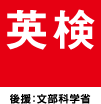- EIKEN (English)
- About Eiken
- History
History
Timeline
| 1961 | Japan’s Social Education Council issues a report to the Ministry of Education recommending that a system of certificated proficiency tests be introduced for various disciplines as a way to further motivate the nation’s learners. |
|---|---|
| 1963 | The Society for Testing English Proficiency (STEP) is established for the purpose of popularizing and improving practical English in Japan. With the ministry's backing, the Jitsuyo Eigo Gino Kentei (Test in Practical English Proficiency) is administered in July in all 47 Japanese prefectures. Nearly 38,000 examinees sign up for this first edition of the EIKEN test, which is offered in three bands: Grade 1 (advanced), Grade 2 (intermediate), and Grade 3 (beginner). Each band includes a direct speaking test for candidates who pass the paper-and-pencil stage. Over the next eight years, the tests will be given twice annually—summer and fall—to a growing number of examinees. |
| 1966 | As EIKEN gains prominence across the country, particularly in junior high schools and high schools, STEP introduces a fourth band, Grade 4, to address the need for an elementary-level assessment. |
| 1968 | Based on the effectiveness of EIKEN during its first five years and its growing social role, the Ministry of Education grants official authorization to the test. |
| 1970 | Responding to requests mainly from junior high schools that students be given more opportunities to take the test, a winter session is introduced for Grade 4. |
| 1987 | STEP introduces two additional EIKEN bands: Grade Pre-1 to address the ability level between Grades 1 and 2, and Grade 5 for early beginners. Also introduced is a system of grants to support research into English-language acquisition, the STEP Research Assistance Program. |
| 1991 | As the use of EIKEN at junior high schools and high schools continues to grow, STEP introduces a closed test-site system, allowing schools to privately administer the written stage of Grade 2, Grade 3, and Grade 4. This improves accessibility for young examinees, who can now sit for EIKEN in their own classrooms rather than traveling to a public test site. |
| 1994 | With the addition of Grade Pre-2 to assess the ability level between Grades 2 and 3, EIKEN is now offered in seven bands. This year also marks the introduction of Jido Eiken, a program of English-learning activities for young children. Oral Communication enters the curriculum in Japanese high schools. |
| 1997 | Under the motto “More Communicative”, EIKEN is revised to reflect changes in school curriculum, pedagogy, and test theory. The revisions focus primarily on the speaking tests, with tasks and criteria modified to better assess communicative competence. |
| 2000 | The Ministry of Education introduces new regulations for the government authorization of proficiency tests. Under the new system, EIKEN is again designated as the ministry-authorized English proficiency certification test for Japan. |
| 2001 | With the addition of a winter session for Grades 1 and Pre-1, all EIKEN grades are now offered three times annually. |
| 2002 | Tasks for the written stage of Grades 3, 4, and 5 are revised to more effectively assess how examinees would perform in real-life situations. |
| 2003 | STEP and the University of Cambridge ESOL Examinations hold a press conference at the British Embassy in Tokyo to mark the launch of a strategic partnership. In the United States, Wartburg College (Waverly, Iowa) announces that EIKEN test results will now be accepted as proof of English proficiency for international admissions. |
| 2004 | With the completion of revisions to the written stage of Grades 1 and Pre-1, all EIKEN grades have now been revised during the period 2002-2004. In September, STEP and Cambridge ESOL release a jointly branded version of the popular Business Language Testing Service (BULATS), a test of business English for the workplace. |
| 2006 | In Australia, the government of New South Wales announces that EIKEN results are now accepted for admission to all Technical and Further Education (TAFE) institutes and all 300 state high schools. |
| 2007 | The total number of EIKEN examinees since 1963 reaches 80 million. |
| 2009 | STEP launches the Jido Eiken Online Version. STEP and the British Council announce a cooperative agreement to deliver IELTS in Japan. STEP and Sophia University announce a partnership to design, produce, and deliver the Test of English for Academic Purposes (TEAP). EIKEN is now recognized at 330 U.S. colleges and universities and at over 400 locations in Australia. |
| 2010 | STEP launches a more comprehensive English website in response to increasing requests for English-language information about the EIKEN tests. The first STEP-administered IELTS test session, held in April, reaches full capacity. A new and more detailed score-reporting system is introduced for EIKEN examinees, providing a wider range of specific feedback regarding test performance. |
| 2012 | In conjunction with its recognition by MEXT as a public-interest incorporated foundation in April 2012, and to commemorate the occasion of its 50th anniversary, Nihon Eigo Kentei Kyokai unveils a new corporate logo and changes its English name to Eiken Foundation of Japan. |
2013
50th anniversary of the establishment of Eiken
Eiken 50th Anniversary Commemorative Event
The Eiken Foundation of Japan was established in April 1963 for the purpose of popularizing and improving practical English in Japanese society. Beginning with the first administration of the EIKEN tests, the foundation has received the support of test administrators, interview examiners, and educators across the country. It is through their efforts that the foundation was able to reach the milestone of its 50th anniversary.
With over 90 million candidates having taken the EIKEN tests as of 2012, the foundation continues to contribute toward the cultivation of global human resources through its testing and learning services.
Here is an overview of Eiken 50th Anniversary Commemorative Event held on August 8, 2013.
